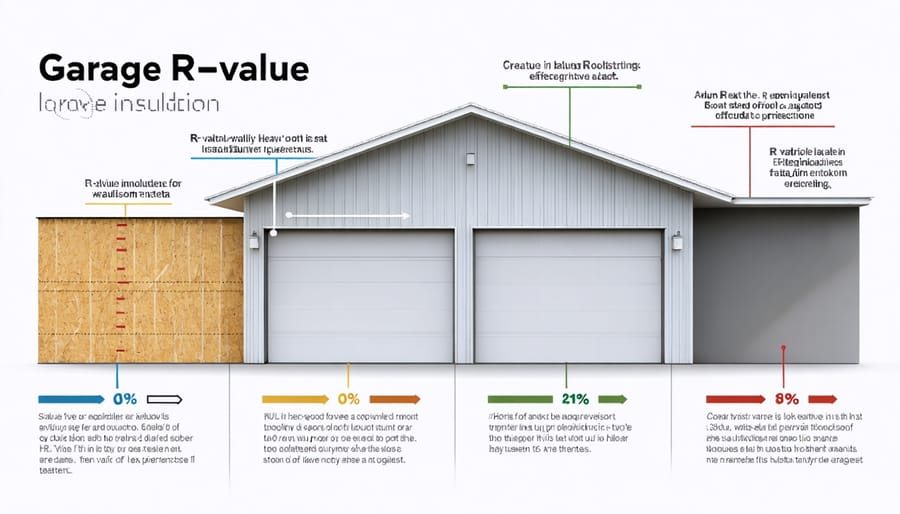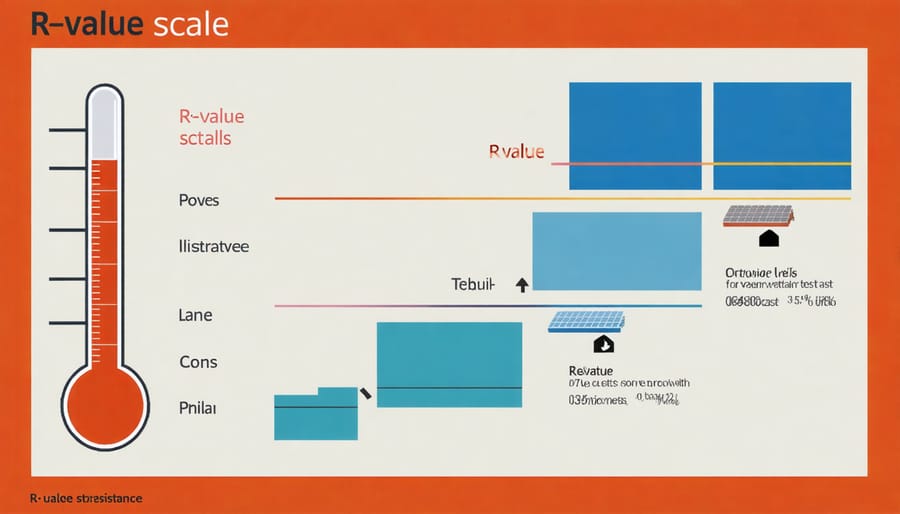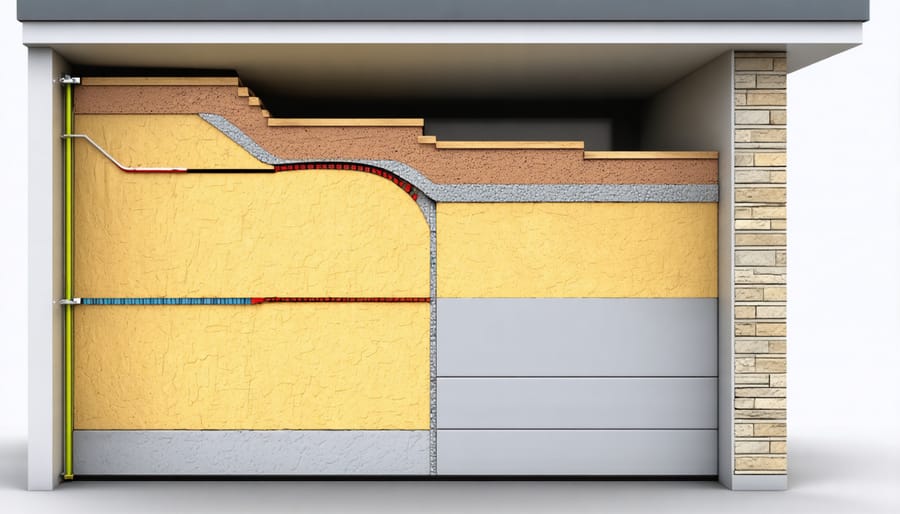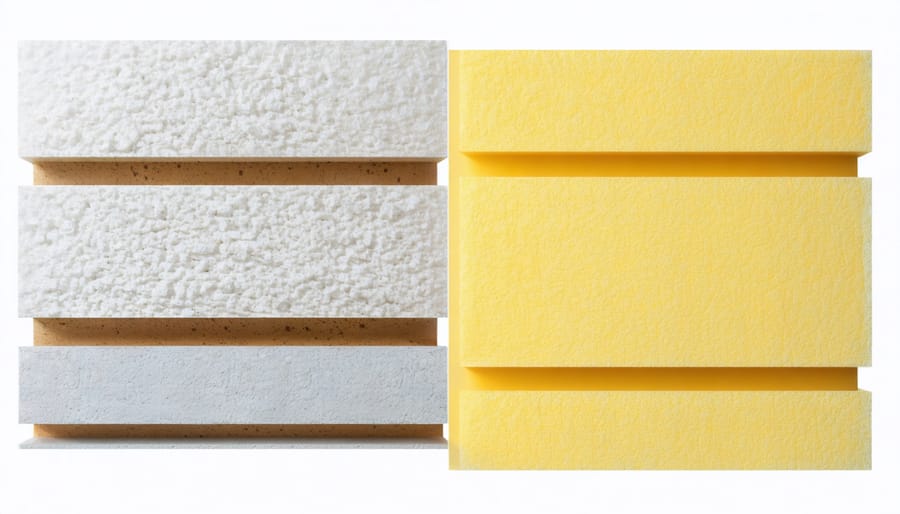Perfect Your Garage Temperature: R-Value Secrets for Better Insulation

Properly insulating your garage can slash energy costs by up to 20% and transform an uncomfortable space into a year-round workshop or storage area. Understanding R-value – the measure of insulation’s heat-blocking effectiveness – is crucial for achieving optimal temperature control in your garage. While standard home walls typically require R-13 to R-23, garages face unique challenges due to large door openings, concrete floors, and varied usage patterns. The right insulation R-value not only ensures comfort but also prevents moisture buildup, protects stored items, and enhances your home’s overall energy efficiency. Whether you’re planning a DIY project or hiring professionals, knowing the recommended R-values for different garage areas (walls: R-13 minimum, ceiling: R-30 to R-49, doors: R-8) will help you make informed decisions about materials and installation methods.
What R-Value Means for Your Garage
Understanding R-Value Ratings
R-values measure how well insulation resists heat flow – the higher the R-value, the better the insulation performs. Think of it like layers of warmth: an R-value of 13 provides more thermal protection than R-8. For every inch of thickness, different insulation materials offer varying R-values. For example, fiberglass batting typically provides R-3 to R-4 per inch, while spray foam can deliver R-6 to R-7 per inch.
When you see insulation labeled as “R-13” or “R-19,” this number represents the total resistance to heat flow for that specific product at its full thickness. Keep in mind that R-values are additive – if you layer two R-13 batts, you’ll get R-26 total insulation value. However, compressed insulation loses effectiveness, so proper installation is crucial for achieving the rated R-value.
Understanding these numbers helps you choose the right insulation for your garage’s climate needs and local building codes.

Temperature Control and Energy Savings
Proper garage insulation with the right R-value can dramatically impact both temperature control and energy savings benefits. A garage with R-13 to R-15 insulation can maintain temperatures within 10-15 degrees of your home’s interior, making it more comfortable for year-round use. During summer months, well-insulated garages typically stay 20-30 degrees cooler than outdoor temperatures, while winter temperatures remain significantly warmer than outside.
Higher R-values directly correlate with reduced energy costs. Homeowners often report 10-20% savings on their heating and cooling bills after properly insulating their garage, particularly if it’s attached to the house. This improvement is most noticeable in regions with extreme temperatures, where inadequate insulation can force HVAC systems to work harder to maintain comfortable indoor temperatures. For optimal results, combine proper insulation with weatherstripping and door seals to create a complete thermal barrier.
Recommended R-Values for Different Garage Areas
Wall Insulation Requirements
When it comes to garage wall insulation, your climate zone plays a crucial role in determining the right R-value. For most homes in moderate climates, an R-13 to R-15 value is recommended for garage walls. However, if you live in colder regions like the northern United States or Canada, consider upgrading to R-19 or even R-21 for better thermal protection.
For attached garages, matching your home’s wall insulation R-value is ideal, as this creates a consistent thermal barrier. Most building codes require a minimum of R-13 for garage walls, but exceeding this requirement can lead to better temperature control and energy savings.
Consider these climate-based recommendations:
– Warm climates (Zones 1-3): R-13 to R-15
– Mixed climates (Zones 4-5): R-15 to R-19
– Cold climates (Zones 6-7): R-19 to R-21
– Very cold/Arctic (Zone 8): R-21 or higher
Remember to properly seal any gaps or cracks in your walls before installing insulation, as air leakage can significantly reduce insulation effectiveness. For the best results, combine your wall insulation with proper air sealing and vapor barriers appropriate for your climate zone.

Ceiling and Roof Considerations
The ceiling and roof area of your garage deserves special attention when it comes to insulation, as heat naturally rises and can escape through these surfaces. For most climates, experts recommend an R-value of R-30 to R-49 for garage ceilings, which is higher than what’s typically needed for walls. This increased insulation helps prevent heat loss during winter and keeps your garage cooler in summer.
When insulating your garage ceiling, consider whether you have a finished attic space above. If there’s an unfinished attic, you can lay thick batts or blown-in insulation directly on the ceiling. For finished rooms above the garage, ensure proper air sealing before installing insulation to prevent moisture issues and maintain comfort in the upper space.
Don’t forget about proper ventilation when insulating your garage ceiling. Proper airflow helps prevent moisture buildup and extends the life of your insulation. Installing soffit vents and ridge vents creates natural air circulation while maintaining the effectiveness of your insulation system.
Consider using faced insulation batts for ceiling installation, as the vapor barrier helps manage moisture movement. For the best results, install the facing toward the heated side of your garage.
Garage Door Insulation Specs
Garage doors typically have lower R-values than walls, ranging from R-4 to R-9, making them a critical area for heat loss. A standard uninsulated garage door only offers around R-2, while an insulated door can provide R-9 or higher. When selecting garage door insulation, consider both the material and thickness – reflective foil-faced rigid foam offers excellent results, while vinyl-backed fiberglass batts are budget-friendly alternatives. For optimal performance, look for doors with thermal breaks between panels and weatherstripping around the edges. Remember that even a moderately insulated garage door can significantly improve your garage’s overall comfort and energy efficiency, especially in extreme weather conditions.

Common Insulation Materials and Their R-Values
Fiberglass Insulation
Fiberglass insulation remains one of the most popular choices for garage insulation, offering an excellent balance of performance and affordability. Standard fiberglass batts typically provide R-13 to R-15 for 2×4 walls and R-19 to R-21 for 2×6 walls. For garage ceilings, you can opt for higher R-values ranging from R-30 to R-38, which is particularly important for preventing heat loss through the roof.
The faced version, with its paper or foil backing, works well for unfinished garage walls, acting as both insulation and vapor barrier. Unfaced batts are ideal for adding layers or working around existing insulation. When installing in walls, ensure the material fits snugly between studs without compression, as squeezing reduces its effectiveness. For optimal performance, pair fiberglass insulation with proper air sealing around outlets, windows, and doors.
Foam Board Solutions
Rigid foam board insulation offers an excellent solution for garage insulation, providing impressive R-values in a relatively thin profile. These boards typically come in three main types: expanded polystyrene (EPS), extruded polystyrene (XPS), and polyisocyanurate (polyiso). Each inch of EPS provides R-4, while XPS offers R-5 per inch, and polyiso delivers the highest value at R-6 to R-6.5 per inch.
What makes foam boards particularly attractive for garage insulation is their moisture resistance and ease of installation. They can be cut to size with a utility knife and installed directly against garage walls or between studs. For the best results, seal the edges with foam-compatible tape to create an effective air barrier. Many homeowners appreciate that foam boards create a smooth, finished surface that’s easy to clean and maintains a neat appearance in the garage.
Spray Foam Options
Spray foam insulation comes in two main varieties: open-cell and closed-cell. Closed-cell spray foam offers an impressive R-value of 6.0 to 7.0 per inch, making it one of the most efficient insulation options available. Open-cell foam provides about R-3.5 per inch, which is still effective but requires more thickness to achieve the same insulation level.
When applied, spray foam expands to fill gaps and create an airtight seal, making it particularly effective for irregular spaces and around obstacles like pipes and wiring. While it’s typically more expensive than traditional insulation materials, its superior performance and ability to act as both insulation and air barrier often justify the investment.
For optimal results in garage applications, closed-cell foam is usually recommended due to its higher R-value and moisture resistance. A 2-inch layer provides R-12 to R-14, meeting most garage insulation needs.
Alternative Materials
Beyond traditional fiberglass, several effective insulation alternatives can enhance your garage’s thermal efficiency. Spray foam offers superior coverage with R-values between R-6 and R-7 per inch, making it excellent for tight spaces and irregular surfaces. Rigid foam boards provide consistent R-values of R-4 to R-6.5 per inch and are perfect for walls and ceilings. For those interested in eco-friendly insulation materials, cellulose (made from recycled paper) delivers R-3.5 per inch while being environmentally conscious. Mineral wool, also known as rock wool, offers R-3.7 per inch and excellent fire resistance. Polyisocyanurate (polyiso) boards provide the highest R-value per inch at R-6.5 to R-6.8, making them ideal for spaces where maximum insulation in minimal thickness is needed.
Installation Tips for Maximum R-Value Performance
To achieve maximum R-value performance from your garage insulation, proper installation is crucial. Start by thoroughly cleaning and inspecting the garage walls and ceiling, addressing any gaps or cracks that could compromise insulation effectiveness. A clean, sealed surface ensures your insulation will perform as rated.
When installing batts or rolls, avoid compressing the material, as this reduces its R-value significantly. Leave the full thickness as intended by the manufacturer. Pay special attention to corners and edges, ensuring complete coverage without gaps. For optimal performance, use proper spacing between studs and joists, typically 16 or 24 inches on center.
Consider using a vapor barrier to prevent moisture damage and maintain insulation effectiveness over time. Install it on the warm side of the insulation to stop condensation from forming within the material.
For areas around electrical boxes and fixtures, carefully cut the insulation to fit snugly without cramming or bunching. Use insulation supports or wire holders to keep the material in place, especially in ceiling applications where gravity might cause sagging over time.
Remember to wear appropriate safety gear, including a mask, gloves, and eye protection. Working in good lighting conditions helps ensure precise installation and proper coverage, maximizing your insulation’s R-value performance from day one.
Proper garage insulation is a crucial investment that pays dividends in comfort and energy savings. Remember that walls typically need an R-value of 13-15, while garage ceilings require R-30 to R-49 for optimal performance. When selecting insulation materials, consider both your climate and budget, but don’t compromise on quality. Whether you choose fiberglass batts, spray foam, or rigid foam boards, ensuring proper installation is just as important as the R-value itself. Take action today to transform your garage into a comfortable, energy-efficient space that enhances your home’s value and functionality. With the right insulation choices and careful installation, you’ll enjoy the benefits of a well-insulated garage for years to come.

